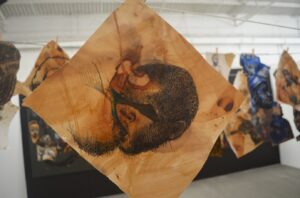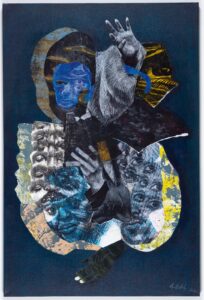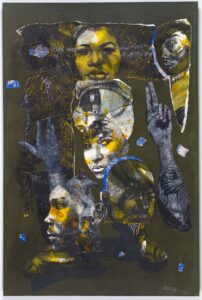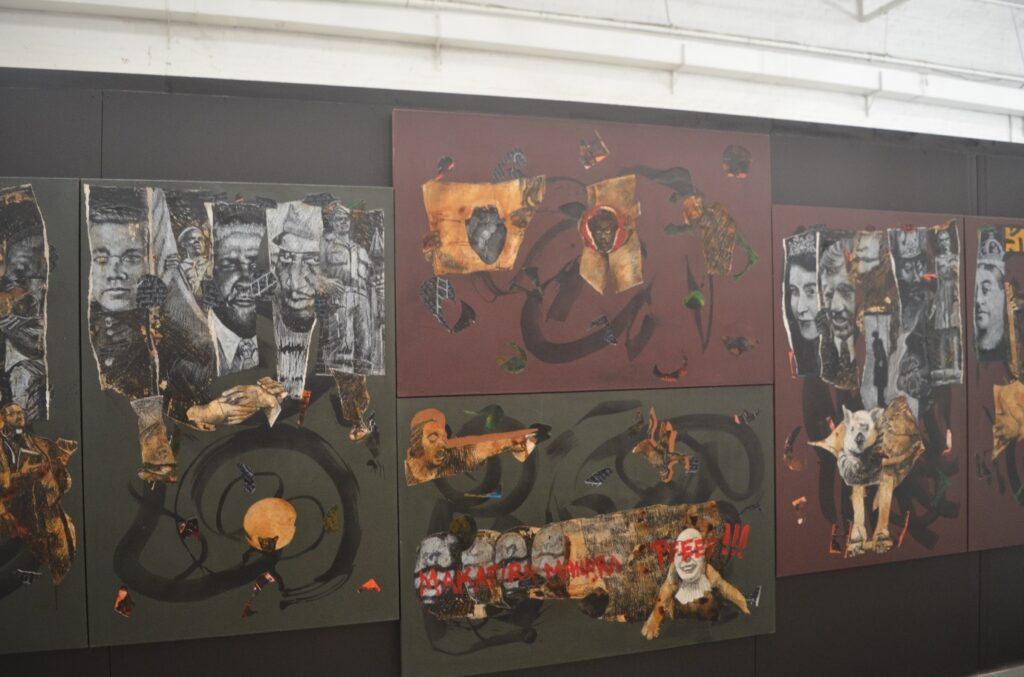
Black lives have always mattered through colonialism, the Atlantic Slave Trade, the Jim Crow era, apartheid, and currently, with the ongoing abuse of Black bodies by the police. The atrocity committed against People of Color around the world clearly indicates that social engineering against us has birthed all the negative repression.
Barnabas Ticha Muvhuti talks with the Zimbabwe-born Ronald Muchatuta
Installation view, Stellenbosch Triennale, 2020, image courtesy Melrose Gallery
In conversation with Ronald Muchatuta
Ronald Muchauta is an artist whose modern practice engages the critical issues affecting the continent of Africa and its relations with the rest of the world. The Cape Town-based, Zimbabwe-born, contemporary artist uses various media that include drawing, mosaics, painting, and collage to articulate his ideas. In this interview, researcher Barnabas Ticha Muvhuti caught up with the artist to talk about his recent exhibition at The Melrose Gallery in Johannesburg, his participation in the Stellenbosch Triennale just before the world went into the lockdown phase due to the coronavirus pandemic and current topical issues including Black Lives Matter and the human rights abuses by the military junta-backed leadership in his country of birth.

Yellow, 2020, collage drawings. acrylic on canvas, 150 x 100 cm, image courtesy Melrose Gallery
Firstly, congratulations for putting together a solo show in the middle of a global crisis due to the COVID-19 pandemic. Tell me more about the body of work and what inspired it?
Thank you. The title of my recent solo exhibition is Kurarama which is Shona for “To Survive.”
The body of work focuses on the things that make us human viz à viz the emotions, characteristics, spirituality, death/life, etc. It is about things that we take for granted, or do not notice at all, that influence our adaptation and internal evolution as human beings. The inspiration for the work came from my shift into a wider colour palette. I felt it was necessary to feed into themes or moods that work well with the colours I was using.
Did you plan to have a solo exhibition in the middle of the year, or this was your response to the hours of confinement due to the lockdown?
The preparation for the show was quite organic as one process led to another. I had started most of the work before the lockdown. The plans for a solo show were on the table, and it was just a matter of timing. At times, one must consider that there is no such thing as the right time to do things, but we like to contradict ourselves as creatives by saying there is. At the end of the day, the emphasis is on taking risks and pushing forward for the right rewards.


Griot/Sun Goddess, 2020, collage drawings, acrylic on canvas, 150 x 100 cm, image courtesy Melrose Gallery
This pandemic has led to the sudden migration of art onto online platforms. I must admit, I am still yet to get to grips with virtual exhibitions. How has the experience been for you as an artist?
The shift has been an interesting one, with everything under the so-called ‘the new normal.’ Fortunately, my exhibition had the chance to be viewed in the physical space of The Melrose Gallery in Johannesburg and on their website as well. What I miss the most is the atmosphere of the exhibition opening nights—the speeches, the wine and the crowds. All of this has been halted.
The idea of having an online show caters well for folks with issues and anxieties due to fear of crowds, as well as those who feel they can enjoy online exhibitions in the comfort of their homes. Economically, it makes sense for some galleries, artists, and collectives that have managed to avoid rental expenses. For me, the physical exhibition space will always reign supreme due to aspects like texture and aesthetic quality of art being more visually pronounced and accessible.
When the pandemic hit our shores, you were taking part in the inaugural Stellenbosch Triennale. Part of your work contested the Zimbabwean ruling elite’s repackaged patriotic narrative, and there was also a performative aspect to it. Would you break it down for me?
My booth at the Stellenbosch Triennale for 2020 consisted of three bodies of work that coexisted to cross-pollinate ideas and energies. The first was Dandaro, which in Shona language means to gather in a circle whether for dialogue or entertainment purposes. Guests engaged and enjoyed nhodo, which is an indigenous game common in Africa. With this work, the idea was to gather people around and make them play while they engaged with the political undertones referencing the exploitation of Africa’s natural and physical resources.

Installation view, Stellenbosch Triennale, 2020
The second component was Chimurenga, which is a Shona word for “Uprising.” In making this installation, my thoughts were to freeze the process of collage and hang the drawings in mid-air on a washing/clothing line. The idea was to give the impression of “works in progress,” while highlighting the plight and cry of marginalized poor people in Zimbabwe and Africa.

Installation view Stellenbosch Triennale, 2020, image courtesy Melrose Gallery
The third aspect of it was When was Zimbabwe ever Great (Great Zimbabwe)? This component consisted of works on canvases that depict a slight visual chronology of Zimbabwean icons from the past, and on the nation’s inception from Rhodesia to Zimbabwe. When was Zimbabwe ever Great?—the phrase was an attempt to spark dialogue amongst fellow Zimbabweans and non-Zimbabweans in South Africa, to challenge the viewer to be part of the work as they respond to the question in their honest terms.
All these art pieces intersect with each other based on colonialism, corruption and the hostile systematic attack on Pan-Africanism, as well as the rebellious energy from the youth through uprisings. Zimbabwe’s struggle is not only the struggle for this beautiful, landlocked country but a struggle for the continent of Africa, too. We cannot have a dialogue about Africa without including Zimbabwe.
I believe the winds of change will blow on Zimbabwe as the ruling party is currently witnessing its last days in power.

Installation view Stellenbosch Triennale, 2020, image courtesy Melrose Gallery
Over the years, I have encountered your drawings, mosaics, paintings and collage. Would you say you have a favorite form of expression?
My favourite form of expression since the early years has always been drawing. I reinforce other mediums to create an extension of my practice, but the underbelly of my influence and energy has always been drawing.
I know you as an artist who reflects on current topical issues. This conversation would not be complete without a word on Black Lives Matter and the events in Zimbabwe.
Black lives have always mattered through colonialism, the Atlantic Slave Trade, the Jim Crow era, apartheid, and currently, with the ongoing abuse of Black bodies by the police. The atrocity committed against People of Color around the world clearly indicates that social engineering against us has birthed all the negative repression.
As someone who has stayed in South Africa for a bit, I can tell you that the experience here can be as toxic as anywhere else. There are some folks who are not happy seeing a vast majority of Black folks gaining prominence and moving up the economic ladder. Marginalized peoples continue to suffer and are disenfranchised through institutional negligence while being labelled “lazy.”
Recently, #ZimbabweanLivesMatter trended on social media in response to the corruption in government and police brutality in my country. When the current administration took over, takapembera chikwambo tichiti mudzimu (we welcomed and celebrated an evil, thinking it was a blessing from the ancestors). Now as we see, the proverb mwana wenyoka inyoka (the child of a snake is a snake) is at play. When the mask fell off, real evil manifested itself and now, we see the grotesque monsters that we entrusted to lead us.
